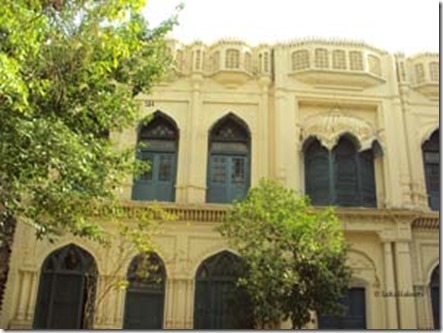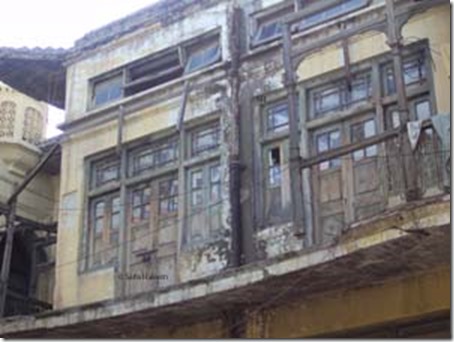Writer and broadcaster, Safia Haleem, shares this story about attending a girls’ school in Peshawar in the North West Frontier Province of Pakistan in the 1950s.
It was 1956 and probably the end of March that my father took me on his bicycle through the narrow streets of Peshawar. I don’t remember whether my parents prepared me for that day or not but I was quite excited to enter a world where my older brother and sister went every day. The word school was a familiar one but still carried a mystery and was associated with the modern world.
The street of the school was familiar to me because I used to pass through these narrow lanes with my maternal grandmother. She went for fabric, silk and wool for knitting as my mother always knitted us beautiful things in winter.
The school was known as “Jogiwarra” which was the name of that street. Jogi in Hindi means a “hermit” and it seems that part of the city was a forest hundreds of years ago as jogis lived under trees. Peshawar is the oldest living city in Asia with a history of over 2000 years. Nobody knows the name of the hermit but we still have very ancient Peepal trees in the old bazaar of city and the ruins of a Buddhist Stupa from the time of King Kanishka were excavated in the beginning of the 20th Century.Our school building was an old temple probably Buddhist, with rooms around a big courtyard which had huge Peepal trees.
I remember vaguely, standing in a courtyard looking around and then found myself in a huge room with many girls of my own age. A lady with red lipstick asked my name and wrote it in a register.
There was a water tank with tap under the spiralling stairs and that spiral went up to the second and third floors. The very top of the building had a bricked courtyard with beautiful facade in the shape of Lotus flower petals. In one corner of that courtyard were the toilets.
It was a primary school for girls only and all the rooms were occupied by the senior classes. The youngest group of children was literally treated as the lowest of the low. Therefore, we had to sit in the courtyard and not in a room.
Looking back it seems so unfair, but at that time we loved to sit on the jute mats spread on the brick floor. During the hot weather, it was bliss to feel the cool floor underneath. There were several open air classes in that courtyard and plenty of view.
All the teachers wore beautiful clothes and high heels.There was a room for the headmistress and near its door, a round copper disc was hanging. We could see that an attendant would come and hit the disc with a wooden hammer. After a few days, I loved the sound of this “bell” as it announced the end of a lesson.
We sat in front of a wooden blackboard placed on a tripod stand. There was a cane chair for the teacher who brought a piece of chalk and a foot long ruler, which was known as “foot”. I don’t remember many things about my lessons, but loved to play hide and seek with a group of girls in that building.
Every class had their own teacher and my teacher was “Susan” – the same lady who wrote my name. She was a Christian but I didn’t know that. She looked like other teachers and always wore red lipstick which I loved. We called them, Apajee, which was a title of respect for an elder sister.
My mother tongue was Pashto but living in the city, I had learnt the local dialect as well which was spoken by most teachers. We were taught in Urdu which was the language of the books. Sometimes, I did not understand what was being taught but there were clever girls who knew everything and they helped.
Each girl had a flat piece of wood known as “Takhti“, a reed pen, inkwell, and a book with alphabet. The teacher wrote with white chalk on the blackboard and we learnt the sounds of the alphabet. Then we wrote on the takhti with the reed pen and black ink which the teacher checked. I made a lot of mess with black ink on my hands, clothes and even my face, but learnt quickly how to drain my pen in the inkwell which had a small piece of cloth.
At some point during the day, we were allowed to go and wash our takhti in the water tank. There would be some green clay known as “gachi” which we rubbed on the damp takhti like soap and made it smooth with hand. Later we would air dry these planks to be ready for the next round of writing. The clay absorbed the ink and it also covered the old ink markings.
There were a number of women attendants known to us as “Amma” (aunt) who escorted us after school and each one of them had a group of girls under their supervision. Every day, when the bell rang in the afternoon we would wait for our “Amma” near the gate and walk with her like chicks around a mother hen. Some girls who were slow or day dreamers like me, would be asked to walk in front so that she could keep an eye on us. She had her own system of taking us through the streets. Some days, she would take a long route and at others she would go the shortest.
After a few weeks, I started going to school with a group of other children from the neighborhood. But, coming home was always with my “Amma” because I loved listening to her stories. She was a very good story teller and although I knew the way to my house, I still followed her.
In the winter months, all the lowest classes were held in the big hall which was used for assembly. The only partition between the three sections was the black board and the teacher’s chair. The jute mats were known as “Taat” which were five to six meters long and a meter wide. They were spread in rows and one row would have seven or eight girls. Those who sat in the front were considered clever and sometimes when they decided to be mean, the last girl would be literally on the cement floor. But the teachers would know and did not allow anyone to have more than their fair share of the space on a mat.
The Taats would be dusted, folded and kept in one corner at the end of the day. It was done by the attendants, after which a woman would come and start sweeping the cemented floor. In the morning, before the assembly, the girls would bring the mats back to the allocated space and spread them in rows. Everyone had their turn and it became a responsibility for us from an early age.
I always sat with my friend behind me except when we fought. If that occurred at the end of the day, either she or I would decide to sit in another row. But it was an unpleasant experience because the girl, whose space was taken, would fight back.
When I passed my first grade, I had a slate added to my three school books. We used the slate for adding numbers and doing sums. It was better than the wooden takhti as it was easy to clean.
The real sponge was rare and only a few girls had pieces to clean their slates. Others would use a dampened cotton piece, sewn with a string and attached to the wooden frame of the slate. Those of us who did not have a sponge or a damp cloth…did the most disgusting things children would do…spat on slates and rubbed with hands while the teachers would scold us if they found out.
We did not have uniform in our school and I wore my sister’s hand-me-downs, my brother’s trousers and even my silk frocks with spangles on. Some girls were always smartly dressed and we knew that they were rich. Others did not have woollen jumpers in severe winter months but they managed somehow.
One day we were all assembled in the courtyard and the headmistress announced that we need to wear specific dress to school every day. It was cotton, sky blue frock and shalwar with white scarf or dupatta. One little girl modelled it for us and I did not like it at all. This was our uniform for the next four years and then in 5th class we started wearing white shalwar with blue frocks. In winter we had bottle green woollen jumpers and later they restricted us to tie our hair with white ribbons only.
Thousands of girls go to school in Peshawar now but they don’t use the learning devices as we did.
© Safia Haleem
Writer and Broadcaster
www.safiahaleem.com
On the theme of girl’ education the article The Queen in Swat on her website is especially interesting.

